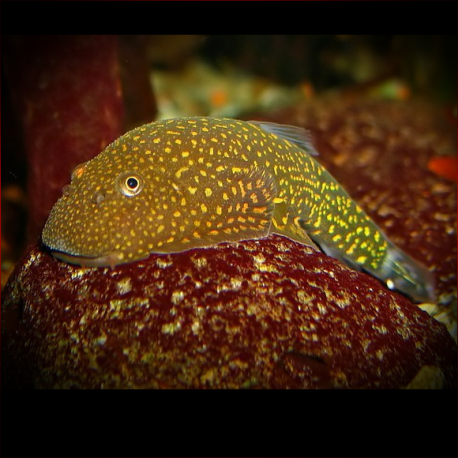More info
Datasheet
| Minimum Tank Size | 90 litres / 23.78 US gallons |
| Maximum Size | 5.5cm / 2.17inches |
| Temperature | 20°C / 68.00°F - 24°C / 75.20°F |
| Hardness | 1.01dgH / 18ppm - 12.05dgH / 215ppm |
| pH | 6.0-7.5 |
General Description
Gastromyzon stellatus is a member of the Gastromyzontidae family known for its dark brown body adorned with numerous yellow spots and a distinct head shape. Endemic to Borneo, these fish have adapted morphology for life in swift, shallow streams and are obligate dwellers in oxygen-saturated waters.
Aquarium Setup
Creating a suitable habitat for Gastromyzon stellatus involves maintaining clean, well-oxygenated water with a recommended turnover of 10-15 times per hour. The tank should include gravel or sand substrate, water-worn rocks, and pebbles with aged driftwood for grazing. Utilizing adaptable aquatic plants and open filter sponges can provide additional food sources while promoting natural biofilm growth.
Behaviour
G. stellatus is a peaceful species with territorial tendencies, often seen protecting prime feeding spots. They exhibit interesting behaviors in loose aggregations and thrive when housed with compatible tankmates such as small cyprinids, gobies, and rheophilic catfishes. Individuals may display varying degrees of protectiveness over their space.
Feeding and Diet
In the wild, G. stellatus feeds on benthic algae and micro-organisms, which can be replicated in captivity with a diet of dried foods, meaty items, and homemade gelatin-bound mixtures rich in fresh vegetables and Spirulina. Maintaining an algae-covered environment is crucial for long-term success, with the potential need for a separate algae-growing tank.
Reproduction & Dimorphism
Breeding G. stellatus in captivity is challenging and rarely observed. Sexual dimorphism is evident in heavier-bodied females, and successful breeding attempts have involved maintaining specific tank conditions and providing suitable spawning substrates. Female individuals are typically larger than males.
Habitat and Distribution
G. stellatus is found in the Sarawak, Sadong, and Lupar River drainages of southern Sarawak, Malaysian Borneo. Endemic to Borneo, these loaches are adapted to swift streams with gravel and rocky substrates, abundant biofilm, and partial to fully shaded environments. They are sympatric with other Gastromyzon species in their natural habitat.

